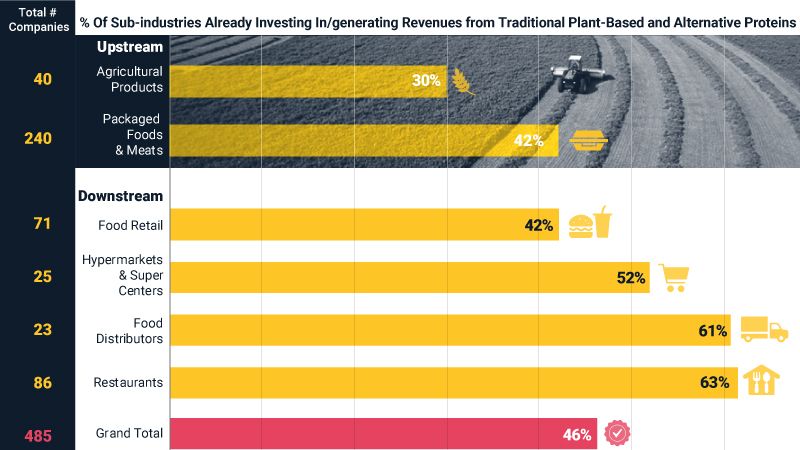Coffee vs Burgers? Biodiversity and The Future of Food
Video
December 2, 2021
Meat or your morning brew? Which would you give up if you had to choose? It's not just a theoretical question. The COP26 Sustainable Agriculture Agenda and the targets of the Kunming Conference scheduled for spring 2022 reflect a dire reality: The global food system accounts for about a third of global greenhouse gas emissions¹ and destroys more nature every year than any other industry.² If we don't drastically change our food production and eating habits, climate change and biodiversity loss will change them for us. Alternative proteins made from plants, fungi or lab-grown meat may be one way the food and agriculture industry shift to compensate for these externalities. The movement is already underway as the chart below shows: more industries have a portion of their revenue tied to sales of alternative proteins. The growth of plant-based proteins in the coming year might be the thing that saves our morning latte.

Percentage of companies from among the MSCI ACWI IMI constituents belonging to the following Global Industry Classification Standard (GICS®) sub-industries: agricultural products, packaged foods and meats, food retail, food distributors, hypermarkets and super centers and restaurants, which generate revenues or invested in traditional plant-based and alternative proteins, across the food value chain, as of July 15, 2021. GICS is the global industry classification standard jointly developed by MSCI and S&P Global Market Intelligence. Source: MSCI ESG Research
¹ "Climate Change and Land: an IPCC special report on climate change, desertification, land degradation, sustainable land management, food security, and greenhouse gas fluxes in terrestrial ecosystems." IPCC, 2020. ² "The global assessment report on Biodiversity and Ecosystem Services." IPBES, 2019.
Subscribe todayto have insights delivered to your inbox.
2022 Trends to Watch
Ten trends for the coming year that could shape the risk profile for investors.
Bacteria Rising: Another Health Crisis Looms
Only major investment in new antibiotics and large reductions in quotidian use may keep millions per year from dying of treatable bacterial infections by 2050.
The Story Behind ESG Trends
10 Year Anniversary – What Can The Past Tell Us About The Future?
The content of this page is for informational purposes only and is intended for institutional professionals with the analytical resources and tools necessary to interpret any performance information. Nothing herein is intended to recommend any product, tool or service. For all references to laws, rules or regulations, please note that the information is provided “as is” and does not constitute legal advice or any binding interpretation. Any approach to comply with regulatory or policy initiatives should be discussed with your own legal counsel and/or the relevant competent authority, as needed.